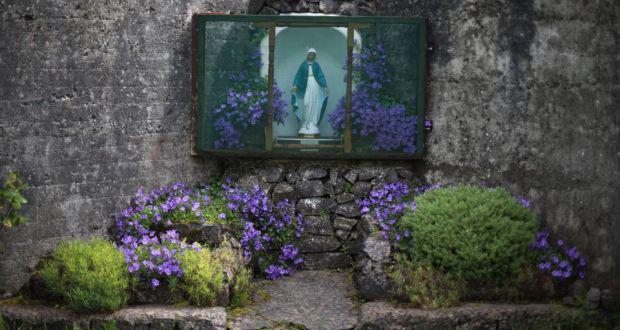|
Casting a fresh eye on the Tuam controversy
By Kathy Sheridan
A visit from the sincerely unloved parish priest was the last thing we needed after a hellish winter’s night holding a bellowing, colicky newborn by her armpits to quell the pain. I cowered nearby while my husband diverted him. But the sonorous voice travelled over several rooms: “There’s nothing as evil as an evil woman,” he boomed, about a case that was making the papers at the time. His next visit was to acknowledge the birth of a second girl-child. In the bafflingly long, uncomfortable silence, he peeled an orange before heading for the door, signing off with a prayerful: “Ah shur mebbe it’ll be a little boy the next time.” Yes, I have baggage where the institutional church is concerned. Most of us do, back through multiple generations. Vile misogyny is only the half of it. But as the media gallops away on another Dan Brown- style Angels and Demons blockbuster, it is all starting to sound a little too convenient. When the kneejerk response to honest reporters or objective historians is a snorted “the cover-up begins”; when it requires real bravery to mildly suggest that perhaps critics might look at historical context, it starts to look a lot like bullying. To see this directed at Irish Times journalists – usually unfairly cast as the cheerleaders of the anti-church regiments – is almost amusing. Is it possible to ask for reflection without risking condemnation as a fellow-traveller?
Older childrenOne popular narrative is that those 796 children who died in the Tuam home between 1925 and 1961 were babies still in swaddling clothes. In fact, well over a fifth of them were more than a year old.There were at least 13 children aged three and over and they were by no means the oldest. There were two nine-year-olds, an eight-year- old, a seven-year-old, a five- year-old and a four-year-old. All girls, oddly. Is that just a coincidence? Was it only girls who were permitted to stay? Were they being lined up for the laundries or was there simply no one to claim them? If there were that many older children among the dead, how many were among the living? Clearly, there are complexities beyond the narrative of forced adoptions. Where were the parents of these older children? Why did so many of them (about a sixth of the total) call their babies Mary? Was it the default choice of the nuns? Yet the demon nuns hardly conjured up names like Sabina Pauline and Sheila Madeline. Or Fabian (not the teen idol of that name, who was only two at the time). Or Thecla. Above all, where were the fathers? About a dozen of the Tuam babies died with congenital syphilis. Who fathered James Frayne, dead at one month? Or Vincent Keogh? Or Josephine Tierney? Or Mary Margaret Finnegan? Or Joseph McWilliam? Or George Gavin? Or John Keane? Or Mary Elizabeth Lydon? Or Vincent Garaghan? Or Mary Kate Ruane? Or Josephine Mahoney? Holy Mother Church rightly stands accused of many things but she hardly doled out doses of syphilis with the dogma. Who fathered Joseph Anth- ony Burke, whose mother was described as an “imbecile”? Or Margaret Elizabeth Cooke, whose mother was an “inmate of [a] mental hospital”?
Plague of infanticideIn 1935, while the Tuam babies were being swept away by catastrophic measles and whooping cough epidemics and the types of debility that continue to kill the poor and the marginalised, a criminal court judge was pondering “the awful plague of infanticide ... over-running the country at the present time”.Between 1922 and 1950, 183 women stood trial for the murder of a newborn. Where were those fathers ? This was the context for Tuam and the other human dustbins of moral Ireland. Not to mention the living conditions outside, such as Limerick’s notorious slums, where hundreds of families lived in places “infested with rats and flies plus an abominable stench which pervades throughout every household”, according to a 1962 report. Yes, the Catholic Church was obsessive about controlling female sexuality but it happened to dovetail neatly with a national obsession over land and property and economic alliances called marriage. How much of this national child-dumping was simple economics? Immaculately conceived babies were not uniquely Irish or Catholic. The Protestant Bethany Home is testament to the second (although its story never quite gained the same traction, interestingly), while all across Canada, Australia and the UK, stories are tumb- ling out about slave-like cond- itions and forced adoptions in mother and baby homes or so-called “baby factories”. Patricia Basquill described how her Ulster Protestant father packed her off, aged 15, to a Church of England home in Newcastle upon Tyne. “We were treated like criminals and told we were entitled to no financial or material help and that if we left with our babies, we would be arrested as a moral danger to ourselves.” On the day they came to take her daughter, she told the London Independent, two women held her down, while a third “ripped” the child from her breast. That was in 1961, the year the Tuam home finally closed its doors. Decades later, the secular hellholes of Romanian and Belarusian orphanages – the baby warehouses of their day – would be exposed to a horrified world. Vincent Browne is on leave
|
.
Any original material on these pages is copyright © BishopAccountability.org 2004. Reproduce freely with attribution.
